The best starting place for an examination of Russian 20th-century visual art is the immediate 19th-century context. Of course, Russian art itself goes back much further, and a full study would require careful consideration of the religious tradition of icon painting (a tradition that was to be resurrected in a secular context at the beginning of the 20th century and by this route play a significant role in Russian modern art). We would also have to consider the appearance of Russian secular painting in the 18th century, and the rise of the "Academy" in the 19th. For our purposes, however, we can begin with a group of artists who gradually broke from the prevailing academic trends and patronage reward systems of the Academy in the late 1860s. Their revolt culminated with the founding of the Tovarishchestvo peredvizhnikh khudozhestvennykh vystavok (The Association of Traveling Art Exhibitions) in 1870-71. The members of the Association were collectively known as the "peredvizhniki" (usually translated in English as "the wanderers"). Among them were most of the best realist painters whose work came to dominate the Russian pictorial scene in the last decades of the 19th century. As opposed to the "Academy" painters, who favored (classical) historical and religious scenes, "the Wanderers" painted primarily Russian subjects in a more or less realistic mode, emphasizing scenes that could be interpreted to have "progressive" or "democratic" content. Their interest in specifically Russian national themes links them with such musicians as Musorgsky, Borodin, and Rimsky-Korsakov, while their painterly realism--which was based, in theory, on a commitment to painting from life--links their work to that of the great Russian 19th- century writers like Dostoevsky, Turgenev, Tolstoy, and Chekhov. The few paintings reproduced here are typical in both style and execution, of the "Wanderer style."
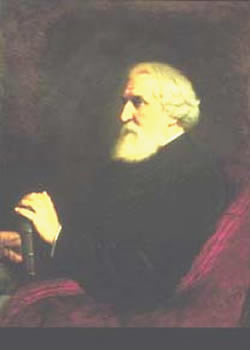 #1
#1
Portraits of major Russian intellectual figures of the period were a specialty of many of
the wanderers. This portrait of the writer Ivan Turgenev (1872) is by Vasily Grigorievich
Perov (1833-82). Note the concern with expressing intense psychology through the
portrait.
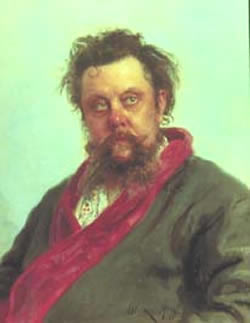 #2
#2
Ilya Efimovich Repin (1844-1930) painted this brilliant portrait of Modest
Musorgsky just weeks before the composer's death, a death hastened by the ravages of an
alcoholism that can clearly be seen on this canvas. The almost cruel naturalism of the
painting has shocked and fascinated viewers since its appearance.
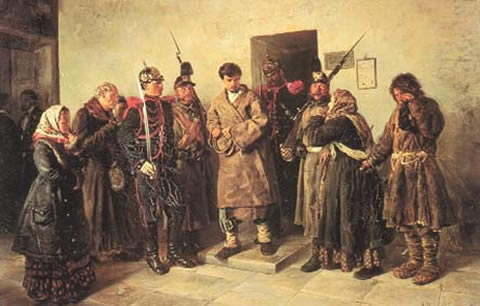 #3
#3
Another major concern of the wanderers was the depiction, usually by
indirect means, of the social injustices of the day. The left-leaning social consciousness of
most of these painters, along with their realistic style, would make them acceptable during
the heyday of Socialist Realism from the 1930s through the end of the Soviet period. In
this painting, "The Condemned" (1872) by Vladimir Egorovich Makovsky (1846-1920),
the prisoner is clearly meant to be a young educated idealist who is being sentenced for
attempts to agitate among the peasants.
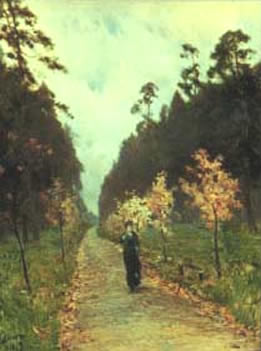 #4
#4
Landscape, particularly melancholy and lyrical views of central Russian
landscapes was another genre at which the wanderers excelled. Although some of these
paintings were attacked for lacking a social message, most of the group produced at least
some work of this type. Perhaps the most famous of the wanderer landscape specialists
was Ivan Ivanovich Shishkin (1832-98). This landscape, entitled "Autumn Day, Sokolniki
Park" (1879) is by Isaac Levitan (1860-1900), a painter who never officially joined the
organization. Nevertheless, he was close to them in spirit. He was also one of the best
friends of Anton Pavlovich Chekhov, and if one wants to imagine the kind of landscape
that would have been in Chekhov's mind as the backdrop for a play like "The Seagull" it
would be hard to beat this.
 #5
#5
Historical painting on Russian themes was another favorite genre of the
wanderers. This work, "The Cossacks Write a Letter to the Sultan" (1891) is by Ilya
Repin. Paintings such as this attempted to capture the vitality and disorder of momentous
occasions in national history. Here, a group of Cossacks, known in Russia for their love of
freedom, alcohol, and bloodshed, pen an insulting letter to the Turkish Sultan, whose
dominions bordered on the Cossack lands. Repin was particularly admired for his ability
to produce lifelike recreations of such scenes, something that Stanislavsky would admire.
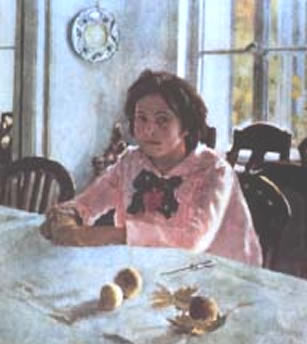 #6
#6
Valentin Serov (1865-1911) was one of the few artists who bridged the
gap between the Wanderers and the symbolist and modernist painters. His lovely "Girl
with Peaches" shows some evidence of the influence of early French impressionism on
Russian painting.